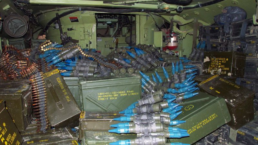As a radioactive material, depleted uranium enters a human body through inhalation or as fragments puncturing the body.
by Danaka Katovich, Truthout
The United States announced plans to send depleted uranium to Ukraine earlier this month. Uranium is very dense, which is useful on the battlefield: Bullets that have elements of depleted uranium can pierce armor, and tanks made of depleted uranium stand up well against enemy fire.
Almost all the reporting about the move includes the clarification that adverse health risks of depleted uranium — a byproduct of uranium enrichment for nuclear reactors and weapons — are not conclusive. Studies cannot find depleted uranium to be the sole cause of illnesses experienced by U.S. service members after returning home from Iraq in the ‘90s and early aughts. But in Fallujah, Iraq, where the U.S. used tons of depleted uranium munitions, the fallout from the 2003 invasion is ongoing, with Iraqi babies still experiencing congenital abnormalities at staggeringly high rates.

Areas of the former Yugoslavia, where depleted uranium was used by North Atlantic Treaty Organization (NATO) forces, are likewise still reaping the consequences. In 1999, NATO used depleted uranium in its attacks on Yugoslavia. In 2001, a UN inquiry led by Pekka Haavisto went to Kosovo to assess radiation levels where depleted uranium was used. He said, “We were surprised to find this a year and a half later. People had collected ammunition shards as souvenirs and there were cows grazing in contaminated areas, which means the contaminated dust can get into the milk.” Just two years after the bombing, nine Balkan veterans in Belgium had been diagnosed with cancer, and five of them had died, according to the New York Times. In Italy, 12 were diagnosed with cancer and six of them died from leukemia.
Recent Posts
Is A Citizens United 2.0 Right Around The Corner?
July 15, 2025
Take Action Now Is it possible for American democracy to be further degraded by the influence of billionaires? Thanks to champion of the working…
U.S. Leaders Gave Up On Diplomacy With Iran. We Must Make Them Return To It.
July 15, 2025
Take Action Now Building an antiwar movement means preventing the systemic U.S. aggression that creates the conditions for war.By Hanieh Jodat,…
What To Do When You See ICE In Your Neighborhood
July 14, 2025
Take Action Now How can you deter the Trump administration’s immigrant deportation machine when it pops up in your community? Follow these…
ICE Campaign Of Violence Will Lead To More Deaths
July 14, 2025
Take Action Now Jaime Alanis’s death shows the horrific consequences of a secret police force behaving with utter impunity.By Natasha Lennard, The…




